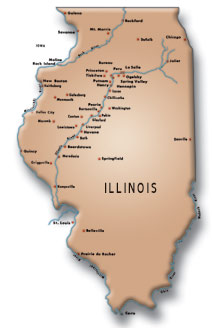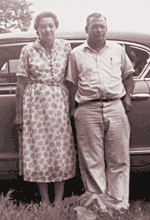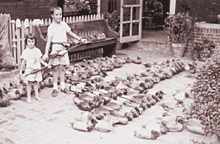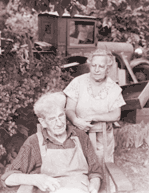by Joe French
| |
 |
| |
Illinois map shows details the author's travels during the early decoy days.
|
I doubt I have ever thrown away any decoy correspondence, from the time I started collecting in Clayton, Missouri until we moved to the Florida Keys in 1971. So it wasn’t much of a surprise when I came across an almost legal pad full of material that I had written at Hal Sorenson’s request for an article on my experiences in the early days of decoy collecting to be used in his next annual Decoy Collectors Guide. It was too bad that Hal never got to the point of publishing that final issue, but glancing through those hand written pages brought back memories of collecting decoys that were often more exciting, certainly different, than collecting decoys today. Since these notes were scribbled over 30 years ago, it should be more accurate than my recollections today.
My introduction to decoy collecting started with Bill Hager lending me a copy of Joel Barber’s book, “Wild Fowl Decoys.” He followed that some time later with a gift of an ancient pair of Mason Premier mallards in original paint that had been retired from service at Hager’s hunting club. I recall shooting over Tru-Dux mallards in original paint. At the time I didn’t give them a thought, they were simply good looking and appeared calm and natural on the water.
After seeing pictures of Shang Wheeler’s birds in Barber’s book, I was fired with a great determination to carve and shoot over the best decoys in our very competitive hunting area of flooded farmland, near where the Illinois River joins the Mississippi, just above the Missouri River. The St. Louis area, where I lived at the time, was the home of the fibre Ariducks factory.
Now the problem was to find Wheeler decoys to examine firsthand. I started by writing the Ducks Unlimited head office and I couldn’t have been luckier. Even a blind sow finds an acorn now and then, proven when the renowned Tom Marshall of Connecticut, who had been a personal friend of Shang Wheeler, answered my letter on June 1, 1954. He advised there was a complete collection of Wheeler’s decoys on display at the Museum of Birdcraft Sanctuary, owned by the Connecticut Audubon Society, in Fairfield. He also suggested I get in touch with Gene Connett and offered to try and get the address of a Bill Mackey.
More letter writing, a trip planned to see my sister in Long Island and a vacation at Nantucket. I then sawed out duck heads to carve while sitting on Nantucket’s beaches.
Gene Connett answered my letter with an invitation to lunch at the New York Yacht Club, starting a friendship I’ll always treasure. He was a super person. When we arrived in New York City the Yacht Club was closed for alterations, so we detoured to the Princeton Club. We talked of ducks, decoys and Derrydale Press, a publishing venture that was his baby, and he introduced me to House of Lords gin martinis, a gin with a golden tint that is now long gone. It tickled me that he was embarrassed that two couples at a nearby table were so noisy. The following year we did go the NY Yacht Club, a pleasure in itself. Gene’s letters were always a joy. He could make a mundane thing into an exciting event.
| |
 |
| |
Hector and Marie Whittington at their home in Oglesby, Illinois.
|
The very next day, having talked to Bill Mackey to arranged a visit, I recall driving up to his charming old colonial house in nearby New Jersey where I found Bill and a house full of decoys, as well as intriguing stories about ferreting out and bringing home old decoys. Bill and Dick Moeller were seemingly collecting together at the time and Dick had just returned from Nantucket with some golden plovers that were very interesting, leading me to think, “Why couldn’t I?” A few years later Moeller sold his collection to the Shelburne Museum.
I had dinner with Bill and his wife at a restaurant in Red Bank overlooking the water. Later as I left his house Bill presented me with a pair of Mark English old squaws, just as Tom Marshall had predicted he would. The collecting seed had been planted!
One thing I’ll always remember is Bill saying he felt about decoys like a chipmunk with his cheeks stuffed full of nuts, but still trying to cram more in, plus juggling still more under his arms and hating to give any up.
As Tom Marshall had advised, I’d written ahead to the Fairfield Museum and contacted Frank Novak, a friend of Wheeler’s who was the curator. There was a collection of stuffed birds, but Shang’s collection of decoys was the prime reason for being there. Frank allowed me to take the birds out of the cases and take pictures of individual decoys.
When I first wrote this the collection was still intact. Some years later the officers of the Connecticut Audubon Society sold the entire collection, donated to them by Remington Arms, to a private collector. While I don’t blame the individual who took advantage of this unique opportunity, I’ve always felt the officers responsible for the sale were derelict in duty and I wonder if they ever asked permission from Remington Arms.
We arrived in Nantucket (Arleen, Helen and Bard) and the “carver” diligently whittled duck heads whenever possible. One day I thought, “Why not try this collecting bit?” So I began asking around the island for leads. After several rebuffs, I was introduced to George Andrews who had a Mason whistler and brant in his boathouse. He also had a whistler by Frank Meiggs, a Nantucket market hunter known as “Tinkey-doughboy,” and an old coot that had belonged to George’s father. All of a sudden I was collecting!
| |
 |
| |
The author's children, Helen and Bard, with a group of decoys that their father had collected.
|
On our way back to St. Louis, we found Joel Barber’s decoys at the Shelburne Museum. They were still in a shed, awaiting their permanent home in the Dorsett House. What a joy to be able to pick up any, take some out and snap pictures on the grass. I ran across a pair of decoys by a Hector Whittington from Oglesby, Illinois that caught my interest. I jotted that name down!
Our last stop was the Henry Ford Museum in Dearborn, Michigan. They had not yet purchased decoys from Bill Mackey, but it was a tremendous museum nonetheless. I was so impressed that I eventually donated examples by the best carvers in each state where decoys were prevalent. (I have been very disappointed they have never displayed the decoys I gave them, or those they purchased from Bill – up to this day in 2002!)
Hunting season was soon upon me, with no time to make the wood bodies I’d planned on carving. I hurriedly carved out some insulating cork bodies, stuck on my painstakingly carved heads, and that was the last effort by “the carver.”
A very lonely decoy collector was I. It’s almost unbelievable, comparing the sea of faces at the National Antique Decoy Show in St. Charles every year with the number of collectors I knew in 1954 – one!
I think back to the generosity of Hal Sorenson and Joe Tonelli in giving out lists of decoy collectors and the fact that Bill Mackey couldn’t ever seem to recall the name of another decoy collector beside Moeller and Joel Barber. The “chipmunk” didn’t want to divulge the source of his acorns.
I wrote letters, letters and more letters. Some to whom I’ve owed letters won’t believe this, but I did have a secretary in St. Louis, more time and no Florida Keys waters to tempt me year round.
 |
|
Frank Cassini made a pair of mallard decoys for the author based on the Tru-Dux design .
|
|
I quote from my first letter from Frank Casinni, a hunter and carver from Galesburg, Illinois. “Would it be that I should be so fortunate as to have a great lover of duck decoys as I living next door to me?” That was June 23, 1955. Frank gave me a beautiful pair of decorative pintails he’d made around 1923. When I moved to the Keys, to insure that no hurricane would ever get them, I gave them to the Henry Ford Museum. Did you here about the fire there around 1969? Yes, gone forever. Many of Mackey’s birds were also burned. However, I’ve sent about 100 since and I know they’ll be safe.
Recently I ran across an early note from Bob Hecht, a book dealer, stating that if I’d send him a couple of bucks, he’d give me the name of a decoy collector. What a bargain that was! It turned out to be Dot and Tom Eshenbaugh of New Cumberland, Pennsylvania, avid decoy collectors for some years and friends of Bill Mackey during that time. The only other real collectors I was able to find – or vice versa – were Carter Smith of Mobile, Alabama, Somers Headley of Wilmington, Delaware, George Starr of Duxbury, Massachusetts and Frank Ash of Oswego, New York – most through the Eshenbaughs. This was my small decoy collecting universe.
With the exception of Mackey, the people I knew didn’t sell decoys. I would send a box of newly acquired decoys and they’d send a box in return. No pre-set trade, just a matter of sharing and trying to send the other fellow a little more than he sent you.
Part of a letter picked at random from a stack of Mackey correspondence read: “Dear Joe, Have started some stuff on a new career with you. A goose, brant, RB merganser – Harry Shourd(e)s, Tuckerton, NJ. Harry was New Jersey great pro. All his stuff has a style – you’ll see it at once. As good as Laing or Holmes and better than Crowell. If you ask me. Also a cypress taproot broadbill from the Accomac Club in Virginia. Just interesting and historical. Then a golden eye of an unusual type. Have fun, Bill.”
The last line of another undated epistle: “Also, the little teal is a pip – Thanks Joe and I hope your package was OK.” Bill was a humorous letter writer and imparted knowledge willingly, especially in the early years, but he never imparted any names. By the late 1950s I also had corresponded with Ted Mulliken, Hal Evans, Lee Smits and Jack Musgrove. My collecting world was growing.
The only reason I had anything to trade was because I wrote Hector Whittington as soon as we returned from our trip east, having found his name at the Shelburne Museum, and arranged a trip that way as soon as possible – which wasn’t soon enough, as I recall. I finally worked out a business trip, starting at Wichita, Kansas and Des Moines, Iowa, where I stopped to see Jack Musgrove, who authored a chapter in Connett’s book, “Wildfowling in the Mississippi Flyway.” I left there with the four top birds pictured opposite page 208.
The business trip “surprisingly” ended up in Oglesby, Illinois. Heck, his wife Marie and I went out to dinner and returned to the house for more decoy looking. Heck had become friends with Shang Wheeler and changed his patterns of many years standing to Shang’s. He named each of the hens in his own hunting rig and signed them on the bottom. He may have done the same with the drakes, but I don’t think so. He had sold decoys for quite a while. I took some pictures in the basement workshop and looked at his decoys plus several he had from Shang. I went back to the motel with some real treasures.
The next day I stopped alongside the highway in Putnam, Illinois and asked the first fellow I saw if he could tell me where I could find Tube Dawson. He looked at his watch and said, “Sure, if you’ll wait about 15 minutes, he’ll be going right by here.” I thought Dawson must be quite the methodical man, until the fellow continued, “You see, it’s his funeral.”
 |
|
The author visited Charles and Edna Perdew on one of his first decoy collecting trips.
|
|
My next stop was the home of Charles and Edna Perdew in Henry, Illinois. Much has been written about this husband and wife team, and the photograph of them used in the first 1964 issue of Decoy Collectors Guide is used in the majority of articles about them. I’ve always felt this picture perfectly captured Edna as a kind, gentle and quiet person. At the time the photo was taken, she no longer painted Charlie’s decoys, her main occupation was taking care of Charlie and her cats, which were many.
Visiting there was a memorable experience. There was a porch across the front of the house, a living room with fireplace to the right of the front door, a dining room back of that, and a kitchen to the left and back of the dining room. I’m telling all this because when I first visited in 1955 you could walk around the front rooms, which may have had a small stack of newspapers by a chair, but lots of cats. As time progressed, so did the stacks. So did the cats. I might say the “whiffin” was quite potent. Later there was so much stacked up that there was just a narrow path to the fireplace, and you could barely get to the dining room table where he did most of the finish work and painting.
I actively worked on Charlie to get him to make me one of each full-size decoy he’d ever carved. Although the DCG article inferred that he only carved smaller decorative birds the last 10 or 12 years, he did produce full size ducks and crows. He always tried to switch me to those miniatures and calls, which I wouldn’t accept, and thus ease his conscience for not having anything ready for me. I never did get them all, but he was very pleased that I caught him in that picture working on a wigeon hen for me.
Charlie Perdew was even more of a saver than I am. Every time I throw away some goodie I’ve hoarded, I need it the next week. I’d say that only happened to him once. After that, he never threw anything away. He was a font of knowledge, but I was always so short of time with so many people I wanted to see that I found it best to get there well after dinner. Even then it was late before I could exit gracefully.
Let me say this: I feel it’s unwise to call any one decoy or decoy maker the best, or the greatest, but I think Charlie’s hollow carved birds are among the greatest of old gunning decoys, and I’d bet many agree.
And don’t forget the time and labor involved in making decoys hollow.
And this was just one of many eventual collecting trips. I’d typically leave Clayton (St. Louis suburb) very early on a Saturday morning with a bunch of empty gunny sacks and often come home with barely enough room for me to squeeze in the car. Many times sacking would be too bulky and I’d have to stack them carefully in the trunk and back seat. Those were fun and happy days, but it took a lot of time and a commitment of effort, all with little time available for travel.
This is the first part in a series on the early days of decoy collecting.
For the complete story, please see the Jan./Feb. 2003 issue of Decoy Magazine.
Tidbits Main Index

|


